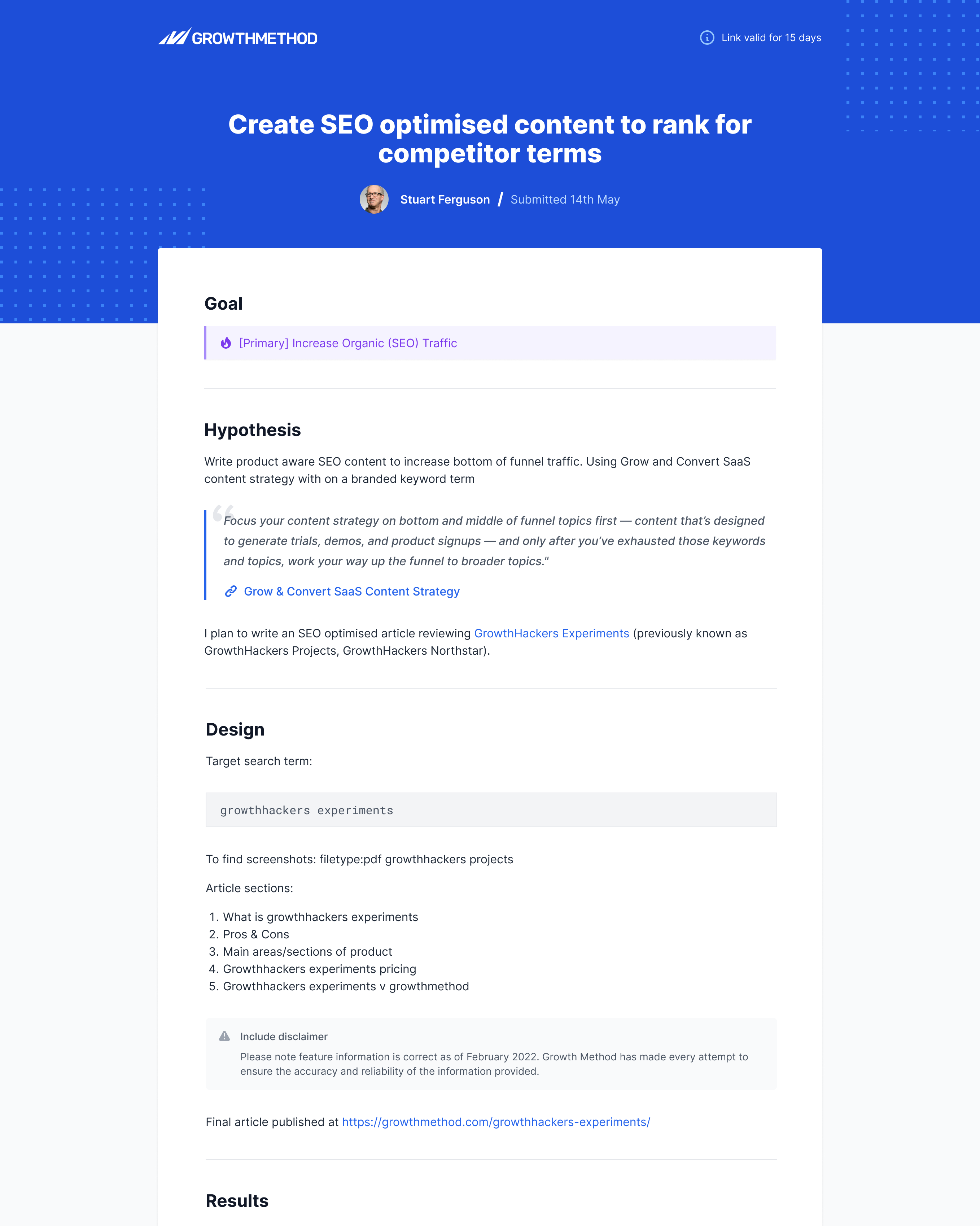How create a world-class growth marketing strategy
Article originally published in December 2022 by Stuart Brameld. Most recent update in March 2024.
Request a demo
Project management for growth and agile marketing professionals. Map your acquisition funnel, integrate analytics and run agile experiments.
Experiment results
Recent experiments results include competitor SEO, AI-driven content, exit-intent modals and AB testing homepage headlines.
Case study
"We are on-track to deliver a 43% increase in inbound leads this year. There is no doubt the adoption of Growth Method is the primary driver behind these results."
![]()
Certified
We are vetted mentors with Growth Mentor and a partner with the Agile Marketing Alliance.
There is no “right” way to build a growth marketing strategy but over time what we’ve found most helpful for customers is for them to have a set of guiding principles to remember as they follow this journey.
Our 7 growth marketing principles are:
- Impact over activity
- Focus over diversification
- Always-on assets over one-off campaigns
- Process over tactics
- Data over opinions
- Speed over perfection
- Outside in vs inside out
Why you need a growth marketing strategy?
Strategy v plan https://growthmethod.com/marketing-plan-vs-marketing-strategy/
You’ve likely heard all this before, so we’ll keep it short, but:
- Marketing teams being required to deliver profitable, efficient growth
- Covid accelerating changes in how people research and buy products and services
- Rapid technology change (including AI) changing the martech tools available
Companies are turning to growth marketing as the solution but what is exactly is growth marketing, and how to you build a best-in-class growth marketing strategy?
What makes a great growth marketing strategy?
Your strategy is a theory about how you will win and why. A strategy is not a plan. For more information see our post on marketing plan vs marketing strategy.
“A long list of “things to do”, often mislabeled as “strategies” or “objectives”, is not a strategy. It is just a list of things to do.
Richard Rumelt, Good Strategy Bad Strategy
Growth marketing operating principles
Clearly, your strategy is unique to you, your team, your business and your goals. Ultimately a growth marketing team needs a healthy mix of testing new things, scaling what works, and optimising what’s already working.
There is no wrong or right way way to approach a growth marketing strategy, however there are some principles and best practises which, in our experience, are critical.
Here are our 10 growth marketing principles:
- Focus over random acts of marketing
- Strategy over tactics
- Impact over activity
- Agency over dependency
- Outside in over inside out
- Compounding assets over one-off campaigns
- Data over opinions
- Speed over perfection
- Evidence-guided over opinion-based (learning)
- Simplicity over complexity
Full funnel consideration
There are typically three ways to grow a business:
- Get more new customers
- Get them to pay more on average
- Get them to come back more often
A growth marketing strategy should consider the entire customer journey and consider not just customer acquisition but post acquisition, retention and expansion as well. Inline with being customer centric (above) understand how you are delivering and measuring value at every step of the journey.
The role of growth marketing should not be limited to top of funnel. They also need to influence conversion throughout the funnel.

If people are generating awareness through people reading our top-of-funnel content, are you actively trying to take some action in order to deepen the relationship, such as asking them to join a newsletter? Once they have taken an initial action, such as the newsletter signup, is there a path to them trying the product? After a trial or demo, what is the path to them then becoming a customer? For existing customers, is there a path to help them to refer others?
Growth is about understanding this full picture of customers.
B2B marketing teams drive growth and efficiency throughout the entire funnel, from building brand awareness to driving new and expansion revenue and creating product and brand champions. B2B marketing teams achieve this by creating value-add “fuel” and building an effective growth “engine” specific to your audience, market, and product.
https://mkt1.substack.com/p/4-ways-marketing-is-different-from
Continuous R&D
Use experimentation (lean, agile or growth marketing) in order to support the rapid generation and testing of ideas, along with rigorous and consistent metrics for evaluation. Iterate on experiments quickly based on your learnings and avoid scaling and integrating into the wider business until they are proven.
All marketing activities follow a curve of growth – you find something that works, over time things change (the channel gets overcrowded, buyer behaviour changes, something new takes off) and the effectiveness of that channel starts to flatten out. Andrew Chen famously described this as the law of shitty clickthroughs.
Regardless of the size of your growth marketing team, you always need to be looking out for the next thing, exploring new channels and programmes. This may be testing a completely new channel, or testing a new innovation within an existing channel. The “but this is how we’ve always done things” argument is a dangerous assumption to make in a fast-moving world. The incentivise to keep things as stable as possible can be alluring in the perception of removing risk, but in fact often increases risk as the marketing strategy stagnates through a lack of innovation.
Adam Grenier calls this the “exploring emerging channels framework” which has 3 core ingredients
- Strengths of the channel. what channel does (strengths of the medium eg Spotify and Clubhouse). What are the strengths of the channel are more important than if channel is hot.
- DNA of the channel – where are they in their trajectory? Have to accept if very early but disappear and probably won’t be a repeatable thing. Also think about what is the monetisation strategy of the channel? Are you aligned
- Own company DNA – risk profile. Do you have appetite to be a first mover? be on dodgy sites, not get refunds etc. Also your channel mix – find some kind of volume and scale on a more stable/basic channel first before going for something more risky. Get fish around first and do more risky exploration after that
Consider the typical length of time between a customers first impression or exposure to your brand and the revenue event (e.g. PO raised). The longer this funnel, the longer the time between the initial impression and the revenue event itself the more opportunity there typically is for experimentation and iteration. The longer the funnel the more opportunities there are for optimisation, and equally the more points there are for failure.


